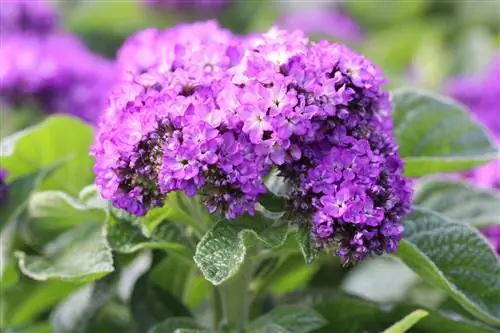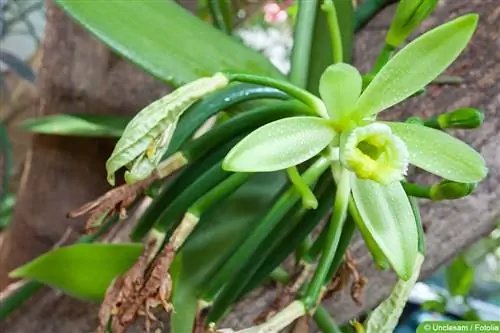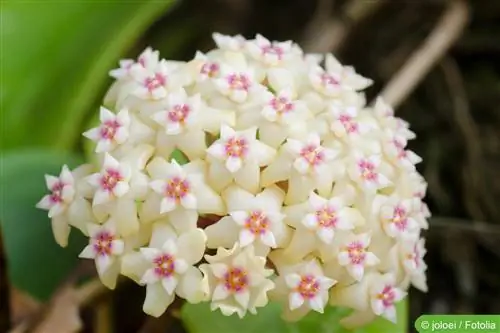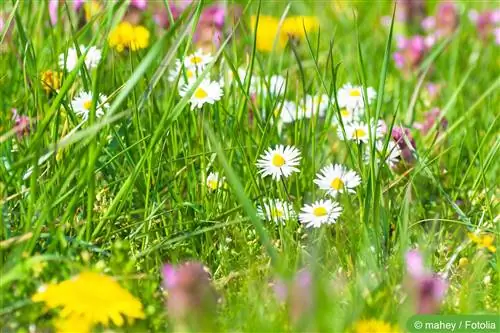- Author admin [email protected].
- Public 2023-12-17 03:39.
- Last modified 2025-01-24 12:45.
The vanilla flower prefers a bright location with lots of sun and protection against wind. If there is too little light, the plant will rot and bend over easily. Older plants need support because the flowers are sometimes very heavy and the stalks cannot support the weight alone.
Vanilla Flower Care Requirements
- Young plants cannot yet tolerate full sun. The flowers are also not rainproof.
- The planting substrate should, if possible, not be too nutrient-rich.
- Permeable, fairly sandy soil without much fertilizer is well suited.
- The vanilla flower requires a relatively large amount of water. A lack of water can be recognized by leaves hanging limply.
Then they get brown edges and eventually dry up completely. The only way to combat this is to water abundantly and never let the plant ball dry out! Even if it looks like the vanilla flower is dying, it can bloom again after a few weeks. You should use fertilizer sparingly for the vanilla flower. Fertilizer is well suited for flowering plants, but only in half the specified concentration.
Flowered flower umbels should be removed after flowering so that new flowers can form.
- The vanilla flower can be overwintered. A bright, cool room is required. Temperatures around 5 ºC are ideal. If the temperatures are higher, a lot of light is required.
- If the vanilla flower becomes quite rotten, you can easily cut it back in spring. It then sprouts well again.
- Propagation is done by cuttings or sowing. It is sown in February or March, preferably in a greenhouse. Vanilla flowers are light germinators.
- Another variant is to sow in June and overwinter the small plants. Then in early spring you already have strong plants that bloom early.
- Cuttings are taken in February from an overwintered plant and placed in a sandy, humus-rich substrate.
The ideal environment
In order to enjoy this wonderfully fragrant flower for a long time, the right environment should be created. The annual plant is an evergreen shrub that is not hardy, but can bloom several times with appropriate care. The normal location should be sunny, but not so that it can shine on the plant all day long. It also always needs a little shade so that it can develop ideally.
Overwintering is a good keyword, because special care is required here: Since the vanilla flower is very sensitive to frost, it should be brought into the house early. During wintering, the vanilla flower should be placed in a bright and cool place that is not too cold. 5°C has proven to be the ideal temperature so that it can be put back in its planned location in spring and delight you with both its pretty lilac flowers and its vanilla smell.
But that's not all: Since the plant naturally continues to grow, the shoots that are too long have to be cut off. The soil should have a certain degree of looseness so that the vanilla flower can develop freely. It should not be fertilized during this time and should only be watered a little but regularly. As soon as you can be sure that the frost period is over, you can enjoy it again. If everything went well during the winter, it will quickly begin to develop new shoots.
Facts about the vanilla flower
- known to botanists as heliotrope
- belongs to the Boraginaceae family
- annual plant
- very tolerable flowering
- Growth height: approx. 50 cm
- Get name through scent
- Flowering period: June/July to autumn
- very sensitive to frost
How to propagate the vanilla flower
As with many other plants and flowers, the vanilla flower can be propagated by cuttings. The branches resulting from the pruning are then dipped in Neudofix, a rooting powder, and then placed in a small pot with potting soil, over which a plastic bag is placed. The powder is, so to speak, the energy drink for plants that need to develop roots. This hormone is available in all well-stocked specialist stores and on the Internet. Here the flower can form roots and grow wonderfully.
As an alternative, seeds can also be purchased from specialist retailers. These are sown in an indoor greenhouse in February/March and then begin to grow a little later. The flowering period begins between June and July and ends in autumn. But it is also possible to enjoy the beautiful flowers as early as May, but for this you would have to buy overwintering plants that are sown in June so that they are nice and strong in autumn.
Wintering in detail
The heliotrope is originally a perennial plant, so overwintering is not a problem. Nevertheless, it is usually referred to in stores and in specialist books as an annual perennial plant. In fact, it can be quite difficult to get the very sensitive solstice through the winter, especially since every owner of this flower has had different experiences. It is important that the vanilla flower must be brought in very early in autumn so that it can overwinter. The heliotrope is particularly demanding when temperatures reach 5°C and it should no longer be left in the garden.
There are various problems with wintering. For some plants it is enough to place them in a cool and bright room. On the other hand, the vanilla flower loves it bright and warm and can overwinter very well in a sunny location at more than 15°C. It is best to place the plant in an east window at around 18°C and only fertilize it very sparingly. The long shoots can be removed before overwintering and fertilization should be stopped during the winter.
The heliotrope is also very unique when it comes to care. It needs a lot of water, but not waterlogging, as the roots will then rot. Luckily, the vanilla flower regenerates quickly if it is kept too dry. As a representative of the tropics, the solstice feels best in a sunny, warm, wind-protected location. In order to provide the flower with the necessary nutrients, you should fertilize the plant with fertilizer for flowering plants during the summer months. However, you can use the intensity of fertilization very sparingly: it is usually sufficient to apply half the usual amount and frequency.
The vanilla flower needs to be pruned regularly. This shows that this is particularly good for the flower. Old flowers must be removed immediately after they fade. In the places where the vanilla flower is cut, branches and thus many new shoots form. In this way it is possible to permanently change the shape of the perennial and enlarge the inflorescence. Normal soil mixed with horn shavings is suitable as soil. It is important to have humus-rich soil that is not overly fertilized.






